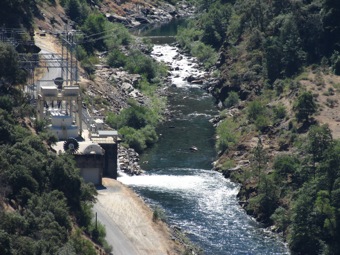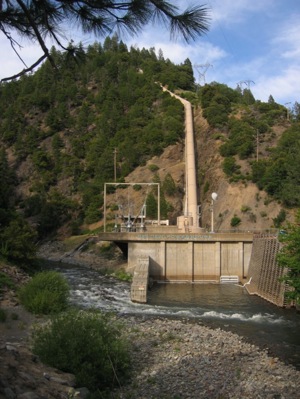And why that could show up in your electric bill
We’ve mapped all of California’s hydropower dams as part of our series on “Water and Power.”

While much is uncertain about California’s warming climate, there is little doubt that it’s already changing the fundamentals of how most of us get our water. In fact, the Bureau of Reclamation has estimated that the Sierra snowpack could be reduced by half as soon as a decade from now.
And that has some far-reaching implications that could even show up on your electric bill.
“When you hear people talk about a depleted snowpack, it’s because of warmer temperatures and the snow just cannot stay in the hills,” says Robert Shibatani, a hydrologist and consultant to numerous government agencies. He says the “hydrograph” for California — the “usual” pattern of precipitation and runoff — is already changing. “There’s no question about it,” he told me in a recent interview. “That’s not an if. It’s not even a when, because I can tell you the when. It’s happening now.”
Shibatani says it’s not that we’ll get less precipitation, necessarily, but warming temperatures will mean more of it falling as rain at higher elevations. And the relatively steady runoff we’ve come to count on to fill the reservoirs and spin the turbines throughout the summer and fall will be compressed into the late winter and early spring.
“What it’s gonna mean is that we’re gonna spill more often,” says Einar Maisch, strategic planning director for the Placer County Water Agency. “And that means we’re gonna lose generation.”
Maisch says his agency is already enlarging spillways to accommodate bigger springtime rushes of water — and he’s prepared to see power generation taper off by 5-to 6 percent at his facilities, which generates more than 200 megawatts of power, purchased by PG&E.
“Water that goes over the top [during those high-pulse periods] does not go through a turbine,” he says.
At other times, there may not be enough runoff to spin the turbines reliably. We had a sneak preview of that during those three dry years in a row that we had recently. Overall, during that time hydro generation was roughly cut in half, says water analyst Juliet Christian-Smith at Oakland’s Pacific Institute. “That has a price tag and an environmental impact as well.”

She ran the numbers and found that as utilities were forced to switch some of the load to natural gas-fired plants to make up the difference, “The cost to electricity consumers was about $1.7 billion dollars.” That’s billion, with a “B.” And here are some more billions from the same time frame: 13 billion additional tons of carbon dioxide emissions because, well, burning natural gas emits CO2 and hydropower does not. Christian-Smith says that, “Given the impact of this drought on our energy production possibilities and the costs that we had to pay for energy, it’s important to think about what a longer and more severe drought might do.”
And there’s another rub, says PCWA’s Maisch. “Hydro is unique.” Not only is it the cheapest form of power imaginable, but it’s the most “dispatchable,” as they say, when utilities need to make quick adjustments to meet fluctuations in electrical demand.
On a tour of one of his agency’s powerhouses, near where the Rubicon River meets the MIddle Fork of the American, “Throttling the needle valves on the Ralston generator over there can change the amount of flow by 50% within 10 minutes. It gives us a tremendous ability to ramp in counter-flow to the changes in the grid.”
That’s not a trivial matter as utilities try to balance a power grid with an increasing percentage of on-again, off-again renewables, like wind and solar. PG&E’s David Moller, who heads the National Hydropower Association, said in a recent company publication that, “The operating flexibility of hydropower is essential to grid reliability and integrating intermittent renewables.” He’s calling for an expansion of hydro, pointing out that of the 80,000 dams across the country, just three percent currently have hydro installed.
But any expansion in California will be a tricky proposition given the environmental sensitivities of the state’s mountain regions. Most projects have recently gone through — or are going through — tortuous renewals of their federal licenses, which usually result in a net reduction of power generated to accommodate environmental concerns. And in California, utilities can’t count hydropower toward their renewable energy targets.
Hear Craig’s companion radio report Monday on KQED’s The California Report. We’ve mapped all of California’s hydropower dams as part of our series on “Water and Power.”
3 thoughts on “Hydropower With a Shrinking Snowpack”
Comments are closed.

Could you explain why Utilities can’t count hydro in CA as a renewable resource?
This is such an interesting question that it probably deserves a separate post. First of all, it’s not quite that simple. Utilities can claim “small hydro,” defined as operations with outputs of 30 MW or less–but anything bigger is not eligible. The rationale seems to be that the state wants to encourage development of “new” renewable sources and it does not want to explicitly encourage the building of more dams. BTW 30 MW is fairly small. One of the two powerhouses I visited up in Placer County can produce 80 MW with a single turbine–that’s roughly the equivalent of 40 large wind turbines–and this was not an especially big operation on its own.
DCurtin, thanks for the comment. In case you haven’t seen it yet, Craig’s post about it went up today: http://blogs.kqed.org/climatewatch/2012/06/20/is-hydroelectric-power-a-renewable-energy-source/